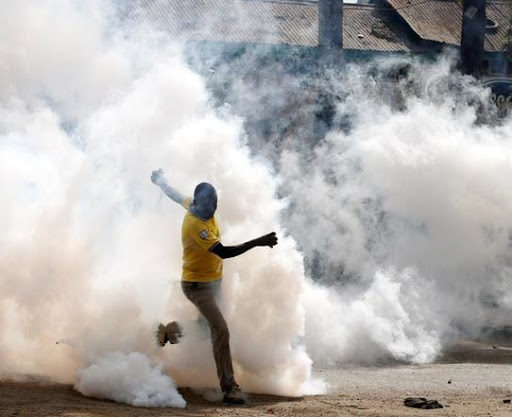
ART CHECK: Artivism in the voice of Bien
His music shapes conscience in revolutionary times
It awakens citizens and forces leaders to pause, look within
In Summary

Audio By Vocalize

In our motherland today, maandamano carries more than bodies. It carries memory. It carries tension. It carries the voice of the youth. It carries the shadow of history and the shape of longing. It is not merely a march. It is not simply refusal. It is the appearance of the unseen. It is the shout of the unheard. It is the drawing of lines on the earth, made not with chalk but with steps.
The street becomes a page. The signs become sentences. The bodies form punctuation. There is no single message. There is a stream. The stream flows from deep places. Not only political, not only economic, not only social. These are names the world gives later. At first, there is only feeling. The sense that something must break its bounds. The sense that something must be witnessed.
To walk in protest is to declare presence. It is to say: I am here. I am not made of silence. I am not formed by waiting. I am not born to observe. The youth walk with arms swinging and eyes open. The chant may rise. The flag may wave. The dust may rise. These are not events alone. These are symbols. In maandamano, the body is not only a tool. It becomes a text.
The text speaks without grammar. It speaks through movement. A stone lifted is a word. A slogan shouted is a paragraph. A silence held is a chapter. The police line is not only resistance. It is a wall of forgetting. Maandamano meets the wall, not with destruction but with declaration. The young do not beg. They do not mimic. They do not recite. They become.
In the air above the procession, a rhythm takes shape. It is not composed by one hand. It emerges. It grows. It folds in the names of those lost. It folds in the price of bread. It folds in the shame of joblessness. It folds in the ache of knowing too much and doing too little. The youth step forward, not as warriors but as witnesses. They witness a nation that speaks of them often and listens to them seldom.
Maandamano is a mirror turned outward. It reflects the cracks. It reflects the promises folded in government papers. It reflects the mouths that spoke of opportunity. It reflects the hands that closed gates. It reflects the faces behind tinted glass. It reflects the law as it walks in boots. Yet the mirror also reflects beauty. The joy of many feet moving as one. The spirit of voices rising in dust. The courage of boys and girls standing where their names are not yet known.
The philosophers of the past spoke of action as the birth of self. In maandamano, the youth become more than names in ledgers. They become agents. The self does not bloom in passivity. It blooms in friction. It blooms in contact. It blooms in refusal to vanish. Each protest is a blooming, even when it ends in tear gas. Even when it ends in blood. Even when it ends in silence again.
The
symbolism does not rest in violence. It rests in exposure. The state stands
revealed. The promises lose their polish. The systems appear as they are. Not
by critique. By confrontation. The confrontation is not always physical. It is
spiritual. It is symbolic. It is ritual. It is the oldest story: the body
claiming space in a place that forgets the body.
In Nairobi this week, maandamano carried echoes from before. The struggle for freedom. The hunger for land. The cry for equality. These echoes do not vanish. They lie under the streets. The youth feel them rise through their soles. Their hands remember even what their minds cannot explain. Maandamano becomes the art of reawakening from sleepy silence.
The
symbols are many. The raised fist. The banner. The whistle. The camera. The
shoes worn out. The back turned. The stone lifted and not thrown. Each object,
a sign. Each sign, a sentence in the living book of the nation. This book is
not archived. It is performed. It is written by walking. It is read by
watching.
In maandamano, the youth do not seek to overthrow meaning. They seek to speak it. They seek to shape it. They seek to fill the public square with more than cars and speeches. They seek to make it a theatre of becoming. Where the body matters. Where presence carries force. Where being visible becomes a kind of authorship.
The need for space becomes visible here. Not space made of land alone. Space made of listening. Of recognition. Of relevance. The youth are not waiting to grow old. They are already full. They are already formed. They are already pressed with questions. They are walking into answers, even when those answers are written in smoke.
Thought roads within our minds carry stories. Some are written in laws. Some are etched in wounds. Some are sung in chants. Some are lost in the clatter of boots. The youth carry all of them.
They
do not choose to walk. They are drawn to walk. The ground itself calls. The
nation is not above them. It is around them. It is in them. They move to find
shape within it.
Philosophy speaks of truth as nearness. Maandamano unites Kenyans closer to its own anthem of nationhood. It forces the state to look within. It forces the leaders to pause. It forces the citizen to ask. What is being said? Who is speaking? What must be heard? The answers may not come quickly. Yet the asking is enough for now. The asking keeps the soul awake.

His music shapes conscience in revolutionary times

He moved philosophical centres even in his death